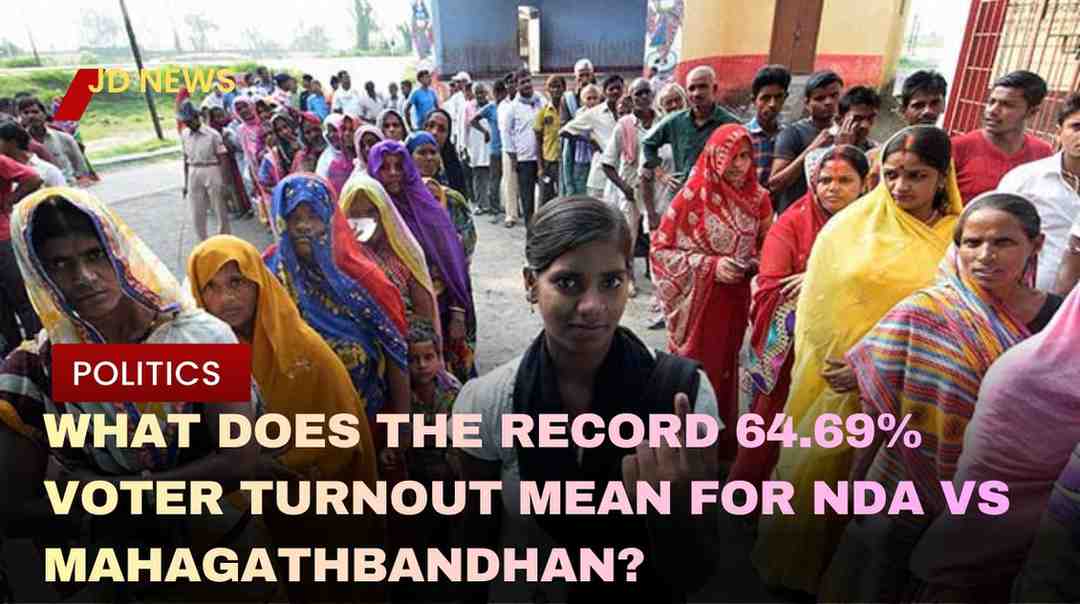Bihar Election 2025: What Does the Record 64.69% Voter Turnout Mean for NDA vs Mahagathbandhan?

Bihar has once again made electoral history. The first round of the 2025 assembly elections saw an impressive 64.69% voter turnout, the most in the state's electoral history for an opening phase. This increase, over 8% higher than the 2020 tally of 56.1%, has sparked political debate over whether the wave represents a yearning for change or a renewed mandate for the current NDA. Over 2.42 crore persons out of 3.75 crore eligible voters cast ballots in 121 constituencies, including 36 lakh more voters than in the previous election - a fact that political experts are reading between the lines.
The sharp increase in participation has brought Bihar's political pulse to the forefront. Historically, high voter turnout has been associated with strong undercurrents of change; however, Bihar's history reflects a more nuanced pattern. When Lalu Prasad Yadav's Rashtriya Janata Dal (RJD) governed the state, turnout frequently above 60%. When Lalu first came to power in 1990, he ended Congress' hegemony with a 62.04% polling percentage. The pattern persisted in 1995 and 2000, with comparable or greater turnouts, cementing RJD's dominance. This pattern prompted many to interpret high attendance as an indication of pro-RJD sentiment, a belief that will now face its most serious test in 2025.
This historical cycle, however, was broken during the Nitish Kumar government. His ascension in 2005 coincided with one of the lowest voter turnouts (46.5%), indicating that political change may occur even in quieter electoral situations. He kept power in consecutive elections with turnouts ranging from 45 to 57%, demonstrating that higher polling does not automatically imply anti-incumbency sentiment. Even in 2020, despite a 57.29% turnout, the NDA held on. With this intricacy, assessing this year's 64.69% turnout is both exciting and unpredictable.
Prashant Kishor's Jan Suraaj Party has joined the race, making numerous contests triangular. In 2020, the NDA and Mahagathbandhan won 60 and 61 seats, respectively, out of the 121 seats up for election. With Kishor appealing to young and first-time voters, commentators believe the high turnout could signal a shift in traditional voting affiliations, potentially splitting the vote in unexpected ways.
Women votes, on the other hand, may be the determining factor this time. Their engagement has skyrocketed, with both alliances making pledges tailored exclusively for them. Nitish Kumar's programs, including as the prohibition law and cycle scheme, continue to garner support, but Tejashwi Yadav's Mahagathbandhan has pledged ₹30,000 in financial help for women to increase their electoral impact. In a state where women's turnout has frequently outpaced men's, their collective decision might sway the balance.
Political scholars warn against misinterpreting a high turnout as a sign of regime change. India's electoral history has yielded various results, ranging from Madhya Pradesh 2023, where record polling brought the BJP back, to Rajasthan 2023, when greater voting unseats the ruling Congress. In Bihar, much will be determined by how regional issues such as unemployment, migration, and local government impact voter mood in various districts.
As the state approaches the second phase on November 11, the stakes could not be higher. With polling patterns fluctuating and alliances adjusting their strategy, Bihar's 2025 election has become a high-voltage political thriller. The answer to whether this high turnout represents continuity or change will be revealed on November 14, when the votes are tabulated.